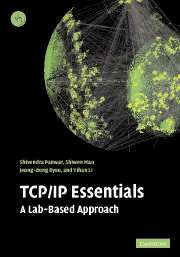Book contents
- Frontmatter
- Contents
- Preface
- Acknowledgements
- General conventions
- List of abbreviations
- 0 TCP/IP overview
- 1 Linux and TCP/IP networking
- 2 A single segment network
- 3 Bridges, LANs and the Cisco IOS
- 4 Static and dynamic routing
- 5 UDP and its applications
- 6 TCP study
- 7 Multicast and realtime service
- 8 The Web, DHCP, NTP and NAT
- 9 Network management and security
- References and further reading
- Appendix A Instructor's guide
- Appendix B Initial configuration of the routers
- Appendix C Source code
- Appendix D List of key requests for comments (RFC)
- Index
2 - A single segment network
Published online by Cambridge University Press: 05 June 2012
- Frontmatter
- Contents
- Preface
- Acknowledgements
- General conventions
- List of abbreviations
- 0 TCP/IP overview
- 1 Linux and TCP/IP networking
- 2 A single segment network
- 3 Bridges, LANs and the Cisco IOS
- 4 Static and dynamic routing
- 5 UDP and its applications
- 6 TCP study
- 7 Multicast and realtime service
- 8 The Web, DHCP, NTP and NAT
- 9 Network management and security
- References and further reading
- Appendix A Instructor's guide
- Appendix B Initial configuration of the routers
- Appendix C Source code
- Appendix D List of key requests for comments (RFC)
- Index
Summary
Metcalfe's Law: “The value of a network grows as the square of the number of its users.”
Robert MetcalfeObjectives
Network interfaces and interface configuration.
Network load and statistics.
The Address Resolution Protocol and its operations.
ICMP messages and Ping.
Concept of subnetting.
Duplicate IP addresses and incorrect subnet masks.
Local area networks
Generally there are two types of networks: point-to-point networks or broadcast networks. A point-to-point network consists of two end hosts connected by a link, whereas in a broadcast network, a number of stations share a common transmission medium. Usually, a point-to-point network is used for long-distance connections, e.g., dialup connections and SONET/SDH links. Local area networks are almost all broadcast networks, e.g., Ethernet or wireless local area networks (LANs).
Point-to-Point networks
The Point-to-Point Protocol (PPP) is a data link protocol for PPP LANs. The main purpose of PPP is encapsulation and transmission of IP datagrams, or other network layer protocol data, over a serial link. Currently, most dial-up Internet access services are provided using PPP.
PPP consists of two types of protocols. The Link Control Protocol (LCP) of PPP is responsible for establishing, configuring, and negotiating the datalink connection, while for each network layer protocol supported by PPP, there is a Network Control Protocol (NCP). For example, the IP Control Protocol (IPCP) is used for transmitting IP datagrams over a PPP link. Once the link is successfully established, the network layer data, i.e., IP datagrams, are encapsulate in PPP frames and transmitted over the serial link.
- Type
- Chapter
- Information
- TCP/IP EssentialsA Lab-Based Approach, pp. 43 - 60Publisher: Cambridge University PressPrint publication year: 2004



